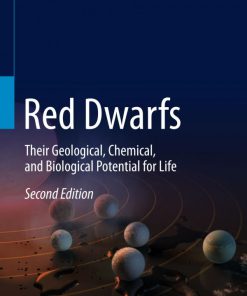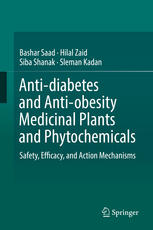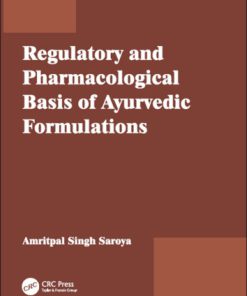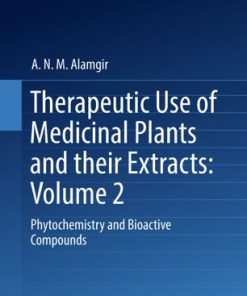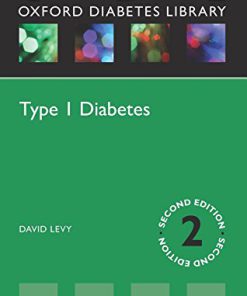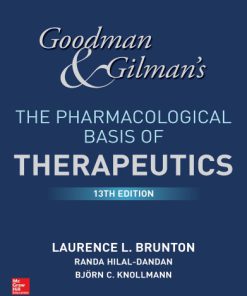Medicinal Foods as Potential Therapies for Type 2 Diabetes and Associated Diseases The Chemical and Pharmacological Basis of their Action 1st edition by Solomon Habtemariam 0081029237 9780081029237
$50.00 Original price was: $50.00.$25.00Current price is: $25.00.
Medicinal Foods as Potential Therapies for Type-2 Diabetes and Associated Diseases: The Chemical and Pharmacological Basis of their Action 1st edition by Solomon Habtemariam – Ebook PDF Instant Download/DeliveryISBN: 0081029237, 9780081029237
Full download Medicinal Foods as Potential Therapies for Type-2 Diabetes and Associated Diseases: The Chemical and Pharmacological Basis of their Action 1st edition after payment.
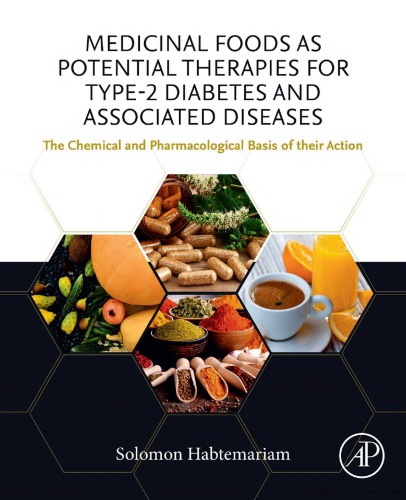
Product details:
ISBN-10 : 0081029237
ISBN-13 : 9780081029237
Author: Solomon Habtemariam
Medicinal Foods as Potential Therapies for Type-2 Diabetes and Associated Diseases: The Chemical and Pharmacological Basis of their Action focuses on active pharmacological principles that modulate diabetes, associated risk factors, complications and the mechanism of action of widely used anti-diabetic herbal plants—rather than just the nutritional composition of certain foods. The book provides up-to-date information on acclaimed antidiabetic super fruits, spices and other food ingredients. Sections cover diabetes and obesity at the global level, the physiological control of carbohydrate and lipid metabolism, the pathophysiology of type-2 diabetes, the chemistry and pharmacology of a variety of spices, and much more.
Medicinal Foods as Potential Therapies for Type-2 Diabetes and Associated Diseases: The Chemical and Pharmacological Basis of their Action 1st Table of contents:
Section A: Type-2 diabetes: Prevalence and significance
Chapter 1: Type-2 diabetes: Definition, diagnosis and significance
Abstract
1.1 Diabetes
1.2 Classification of diabetes
1.3 Diagnosis criteria: Diabetic and prediabetic conditions
1.4 Global prevalence of diabetes
1.5 The social and economic impact of diabetes
Section B: Normal physiological control of carbohydrate and lipid metabolism and some common antidiabetic therapeutic targets
Chapter 2: Glucose metabolism: Normal physiology, diabetic dysregulation, and therapeutic targets
Abstract
2.1 Introduction
2.2 Carbohydrate digestion
2.3 Mechanisms of glucose uptake and transport
2.4 Glycogenesis
2.5 Glycogenolysis
2.6 Gluconeogenesis
2.7 Hormonal regulation of glucose metabolism
2.8 The AMP-activated protein kinase (AMPK) and cellular energy balance regulation
Chapter 3: Lipid metabolism: Normal physiology, dysregulation under obesity and diabetes, and therapeutic targets
Abstract
3.1 Overview of lipids chemistry
3.2 Lipid digestion
3.3 Lipid uptake from the intestine and transport system
3.4 Utilization of lipids as an energy source
3.5 Lipids storage
3.6 De novo fatty acid synthesis
3.7 Hormonal control of lipid metabolism
3.8 Summary of energy homeostasis and hormonal control
Section C: Pathophysiology of type 2 diabetes and therapeutic options
Chapter 4: Pathophysiology of type 2 diabetes complications
Abstract
4.1 Acute emergencies
4.2 Chronic complications of T2D and pathological hallmarks
4.3 Macrovascular diseases
4.4 Molecular mechanisms of diabetes complications
Chapter 5: Current pharmacotherapy options for type 2 diabetes
Abstract
5.1 Type 2 diabetes diagnosis and management by lifestyle change
5.2 Pharmacological management approach for T2D
5.3 Common antidiabetic drugs under clinical use
Chapter 6: Introduction to plant secondary metabolites—From biosynthesis to chemistry and antidiabetic action
Abstract
6.1 The what and why of secondary plant metabolites
6.2 General overview of secondary metabolites biosynthesis
6.3 The terpenoids biosynthesis pathway
6.4 Acetate/polyketide pathway
6.5 The shikimate biosynthesis pathway
6.6 The flavonoids (mixed shikimate and acetate) biosynthesis pathway
6.7 Alkaloids
6.8 Pharmacological principles of drugs action—How do plant food metabolites act?
Section D: Potential modulators of type-2 diabetes and associated diseases: Super fruits
Chapter 7: Bilberries and blueberries as potential modulators of type 2 diabetes and associated diseases
Abstract
7.1 Botanical and taxonomic perspectives
7.2 Common usage and production
7.3 The chemistry of bilberry and blueberry fruits
7.4 Bioavailability and pharmacokinetic profile
7.5 Antidiabetic and antiobesity effects of bilberry and blueberry fruits
7.6 Bilberries/blueberries and diabetes retinopathy
7.7 Some common mechanisms of action of bilberry and blueberry fruits
7.8 Conclusion
Chapter 8: The chemical and pharmacological basis of bitter melon (Momordica charantia L.) as a potential therapy for type 2 diabetes and obesity
Abstract
8.1 Introduction to the plant—Bitter melon
8.2 Taxonomic and botanical considerations
8.3 The chemistry of bitter melon
8.4 Antidiabetic, antiobesity and lipid lowering effects of bitter melon
8.5 Potentially active antidiabetic and/or antiobesity principles of bitter melon
8.6 Mechanism of action of bitter melon and its active principles in diabetes and associated diseases
8.7 Clinical trials
8.8 Potential toxic and other undesirable effects
8.9 Conclusion
Chapter 9: The chemical and pharmacological basis of guava (Psidium guajava L.) as potential therapy for type 2 diabetes and associated diseases
Abstract
9.1 Botanical description and taxonomy
9.2 Guava utilization as food and medicine
9.3 The chemistry of guava
9.4 Antidiabetic, antiobesity and lipid lowering effects of guava—Evidence from in vivo studies
9.5 Detailed mechanism of action from studies on guava extracts in vitro, in vivo and active principles
9.6 Cardiovascular effects: Cardiac hypertrophy and hypertension
9.7 Wound healing effects
9.8 Overview of the guava antidiabetic principles
9.9 Clinical studies
9.10 Conclusions
Chapter 10: The chemical and pharmacological basis of okra (Abelmoschus esculentus (L.) Moench) as potential therapy for type 2 diabetes
Abstract
10.1 Introduction to Abelmoschus esculentus (L.) Moench
10.2 Botanical and taxonomic considerations
10.3 Economic significance
10.4 The chemistry of okra
10.5 Effects of okra extracts and purified compounds on diabetes and associated diseases
10.6 Organoprotective and other effects
10.7 Toxicity
10.8 Related species—Abelmoschus manihot (L.) Medik
10.9 Conclusion
Chapter 11: The chemical and pharmacological basis of papaya (Carica papaya L.) as potential therapy for type-2 diabetes and associated diseases
Abstract
11.1 Botanical and taxonomic considerations
11.2 Papaya utilisation
11.3 The chemistry of papaya
11.4 The pharmacology of papaya related to diabetes and associated diseases
11.5 Toxicological considerations
11.6 Conclusion
Chapter 12: The chemical and pharmacological basis of pomegranate (Punica grantum L.) as potential therapy for type-2 diabetes and metabolic syndrome
Abstract
12.1 Introduction
12.2 Botany and taxonomy
12.3 Uses as food and medicine
12.4 Plant preparations for antidiabetic use
12.5 The chemistry of pomegranate
12.6 Evidence of efficacy from in vitro and in vivo studies
12.7 Evidence of efficacy from clinical studies
12.8 Pharmacokinetics and toxicological perspectives
12.9 General summary and conclusion
Chapter 13: The chemical and pharmacological basis of prickly pear cactus (Opuntia species) as potential therapy for type 2 diabetes and obesity
Abstract
13.1 Introduction
13.2 Taxonomic and botanical perspectives
13.3 Common uses of prickly pear
13.4 The chemistry of cactus pears
13.5 Antidiabetic, antiobesity, and lipid lowering effects of prickly pears
13.6 Active principles of prickly pear
13.7 Diuretic effects
13.8 Human studies on prickly pears
13.9 General summary and conclusions
Chapter 14: The chemical and pharmacological basis of pumpkins (Cucurbita species) as potential therapy for type-2 diabetes
Abstract
14.1 Introduction
14.2 Botanical and taxonomic perspectives
14.3 Ornamental, food, and medicinal values
14.4 Antidiabetic effects of C. pepo
14.5 Antidiabetic effect of C. moschata
14.6 Antidiabetic effects of C. ficifolia
14.7 Antidiabetic effect of C. maxima
14.8 Antidiabetic effect of C. mixta
14.9 Conclusions
Section E: Potential modulators of type-2 diabetes and associated diseases: Spices
Chapter 15: The chemical and pharmacological basis of cinnamon (Cinnamomum species) as potential therapy for type-2 diabetes and associated diseases
Abstract
15.1 Introduction
15.2 Taxonomic and botanical descriptions
15.3 Medicinal uses
15.4 The chemistry of the cinnamon bark
15.5 General pharmacology
15.6 Antidiabetic, antiobesity, and antihyperlipidaemic effects
15.7 Toxicological profile
15.8 Overview of pharmacokinetics profile
15.9 General summary and conclusions
Chapter 16: The chemical and pharmacological basis of cloves (Syzygium aromaticum (L.) Merr. & L.M.Perry) as potential therapy for type 2 diabetes and associated diseases
Abstract
16.1 Introduction
16.2 Botanical and taxonomic perspectives
16.3 Culinary and medicinal uses of clove
16.4 The chemistry of cloves
16.5 Antidiabetic effects—Crude extract and preparations
16.6 Antidiabetic effects—Active principles of cloves
16.7 Antiobesity and antihyperlipidaemic effects
16.8 General summary and conclusion
Chapter 17: The chemical and pharmacological basis of fenugreek (Trigonella foenum-graecum L.) as potential therapy for type 2 diabetes and associated diseases
Abstract
17.1 Botanical and taxonomic perspectives
17.2 Uses as food and medicine
17.3 The chemistry of fenugreek
17.4 Antidiabetic, antihyperlipidaemic, and antiobesity potential of fenugreek
17.5 Adverse effect
17.6 Conclusions
Chapter 18: The chemical and pharmacological basis of ginger (Zingiber officinale Roscoe) as potential therapy for diabetes and metabolic syndrome
Abstract
18.1 Historical perspectives
18.2 Taxonomic and botanical perspectives
18.3 Utilization of ginger as food and medicine
18.4 The chemistry of ginger
18.5 Overview of the pharmacology of ginger
18.6 Antidiabetic effect of ginger
18.7 Antiobesity, lipid lowering, and anticholesterolaemic effects of ginger
18.8 Evidence of ginger in ameliorating cardiovascular diseases and complications
18.9 Antioxidant effects as mechanisms for the diverse effects of ginger in diabetes and associated diseases
18.10 Anti-inflammatory mechanisms
18.11 Ginger in diabetic retinopathy
18.12 Ginger in diabetic nephropathy
18.13 Other organoprotective effects
18.14 Overview of pharmacokinetics profile
18.15 Conclusions
Chapter 19: The chemical and pharmacological basis of garlic (Allium sativum L.) as potential therapy for type 2 diabetes and metabolic syndrome
Abstract
19.1 Taxonomy and origin
19.2 Botany
19.3 Garlic utilization as food and medicine
19.4 Chemistry
19.5 General antidiabetic effect in animal models and human studies
19.6 Evidence of lipid lowering and antiobesity effects from animal and human studies
19.7 Evidence of garlic in ameliorating cardiovascular diseases and complications
19.8 Mechanisms of actions deduced from in vitro, in vivo and human studies
19.9 Garlic in diabetic nephropathy
19.10 Other diabetes complications
19.11 Overview of pharmacokinetics profile
19.12 Toxicity remarks
19.13 Conclusions
Chapter 20: The chemical and pharmacological basis of turmeric (Curcuma longa L.) as potential therapy for type 2 diabetes and metabolic syndrome
Abstract
20.1 Introduction
20.2 The chemistry of turmeric
20.3 General antidiabetic effect in animal models and human studies
20.4 Evidence of lipid lowering and antiobesity effects from animal and human studies
20.5 Neuropathy
20.6 Cardiovascular diseases and complications
20.7 Nephropathy
20.8 Retinopathy
20.9 Wound healing
20.10 Mechanisms of actions deduced from in vitro, in vivo and human studies
20.11 Toxicology and pharmacokinetic profile
20.12 General summary and conclusions
Section F: Potential modulators of type 2 diabetes and associated diseases: Beverages, other foods, and herbal supplements
Chapter 21: Chemical and pharmacological evidences for coffee as a modulator of type 2 diabetes and metabolic syndrome
Abstract
21.1 Introduction
21.2 Economic significance
21.3 Taxonomy and botany
21.4 The chemistry of coffee relevant to potential effect on metabolic syndrome
21.5 The inverse association between coffee drinking and risk for T2D—Epidemiological evidences
21.6 Coffee and its phytochemicals as antidiabetic agents: Evidences from experimental and human studies
21.7 Comments on bioavailability and toxicity
21.8 Conclusions
Chapter 22: The chemical and pharmacological basis of tea (Camellia sinensis (L.) Kuntze) as potential therapy for type 2 diabetes and metabolic syndrome
Abstract
22.1 Introduction to tea (Camellia sinensis (L.) Kuntze)
22.2 The global tea industry
22.3 Botany and taxonomy
22.4 Chemistry
22.5 General antidiabetic, antiobesity and lipid lowering effects in experimental animals
22.6 Mechanism of actions of tea preparations deduced from in vitro and animal studies
22.7 Overview of pharmacokinetics
22.8 Effects of tea on human subjects related to components of metabolic syndrome
22.9 Toxicity considerations
22.10 Conclusion
Chapter 23: The chemical and pharmacological basis of rooibos (Aspalathus linearis (Burm. F.) R. Dahlgren) as potential therapy for type 2 diabetes and metabolic syndrome
Abstract
23.1 Introduction
23.2 Taxonomy and botanical perspectives
23.3 Chemical components relevant to the pharmacology of rooibos
23.4 The pharmacological basis of rooibos for diabetes and metabolic syndrome: In vitro and in vivo evidence
23.5 Mechanism of antidiabetic effect by rooibos and its active components
23.6 Antiobesity and anti-adipogenesis effects and lipid lowering effects
23.7 Cardiovascular effect
23.8 Overview of bioavailability and pharmacokinetics profile of rooibos
23.9 Clinical trials
23.10 Conclusions
Chapter 24: The chemical and pharmacological basis of yerba maté (Ilex paraguariensis A.St.-Hil.) as potential therapy for type 2 diabetes and metabolic syndrome
Abstract
24.1 Introduction
24.2 Botanical and taxonomic perspectives
24.3 Chemistry
24.4 Evidences of efficacy of yerba mate for metabolic syndrome
24.5 General antioxidant effects and mechanisms
24.6 Anti-inflammatory mechanism
24.7 Antihyperglycaemic and other effects on glucose homeostasis
24.8 Antiobesity effect
24.9 Pancreatic lipase and choleretic effects as antiobesity and lipid lowering mechanisms
24.10 Cardiovascular effects
24.11 Clinical trials and toxicological perspectives
24.12 Conclusions
Chapter 25: Other common and exotic foods with growing importance as antidiabetic agents
Abstract
25.1 Cocoa (Theobroma cacao L.)
25.2 Coconut (Cocos nucifera L.)
25.3 Figs (Ficus carica L.)
25.4 Moringa (Moringa oleifera Lam. and Moringa stenopetala (Baker f.) Cufod.)
25.5 Soybean (Glycine max (L.) Merr.)
25.6 Sweet potato (Ipomoea batatas (L.) Lam.)
25.7 Walnuts (Juglans regia L.)
Chapter 26: Antidiabetic herbal medicines rebranded as dietary supplements
Abstract
26.1 Overview of herbal medicines’ rebranding as supplements
26.2 Aloe vera as antidiabetic agent
26.3 Andrographis paniculata (Burm. F.) Wall. Ex Nees as antidiabetic agent
26.4 Banaba—Lagerstroemia speciose (L.) Pers as antidiabetic agent
26.5 Cassia and Senna species
26.6 Ginkgo biloba L.
26.7 Ginseng (Panax ginseng C.A. Mey, P. quinquefolius L. and P. notoginseng)
26.8 Gymnema—Gymnema sylvestre (Retz.) R.Br. ex Sm
26.9 Jamun—Syzygium cumini (L.) Skeels
26.10 Olive leaf extract—Olea europaea (L.)
26.11 Scutellaria—Scutellaria baicalensis Georgi
26.12 St John’s wort—Hypericum perforatum L. Benefits and risks in antidiabetic therapy
26.13 Conclusions
People also search for Medicinal Foods as Potential Therapies for Type-2 Diabetes and Associated Diseases: The Chemical and Pharmacological Basis of their Action 1st
is turkey good for type 2 diabetes
what type of diet is recommended for type 2 diabetes
what are some good recipes for type 2 diabetes
are onions good for type 2 diabetes
medical nutrition therapy for type 2 diabetes
Tags: Medicinal Foods, Potential Therapies, 2 Diabetes, Associated Diseases, The Chemical, Solomon Habtemariam
You may also like…
Medicine - Internal Medicine
Science (General)
Uncategorized
Medicine - Natural Medicine
Medicine
Medicine
Goodman & Gilman’s The Pharmacological Basis of Therapeutics 13th Edition Laurence L. Brunton




